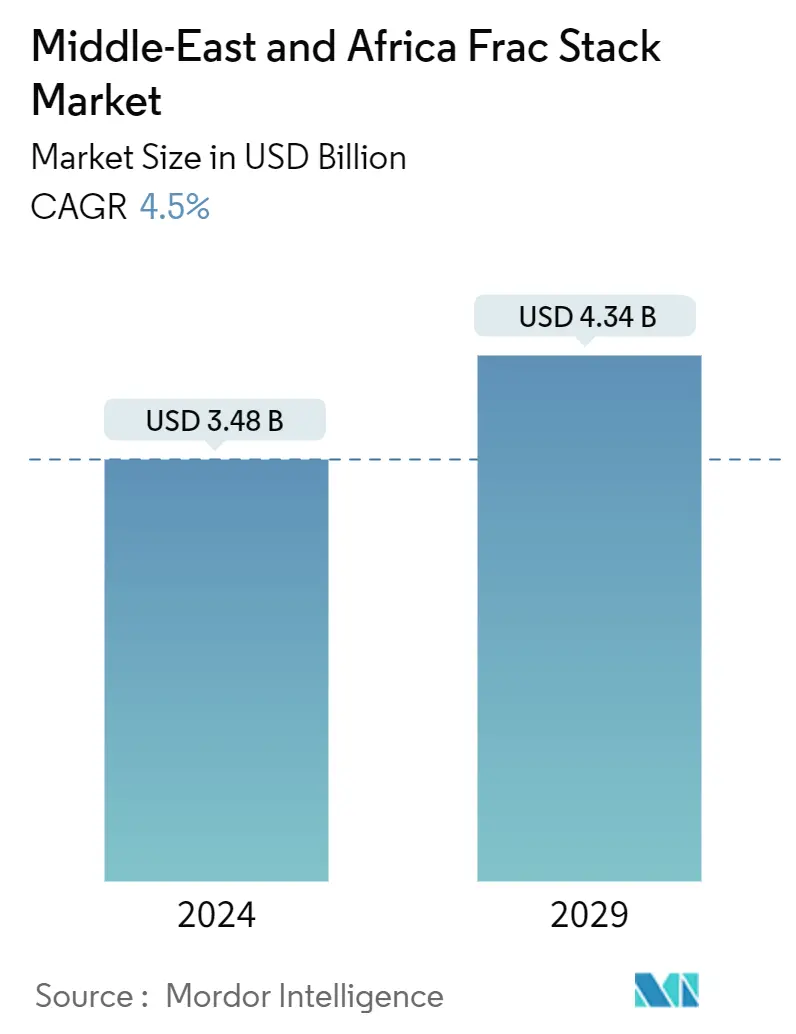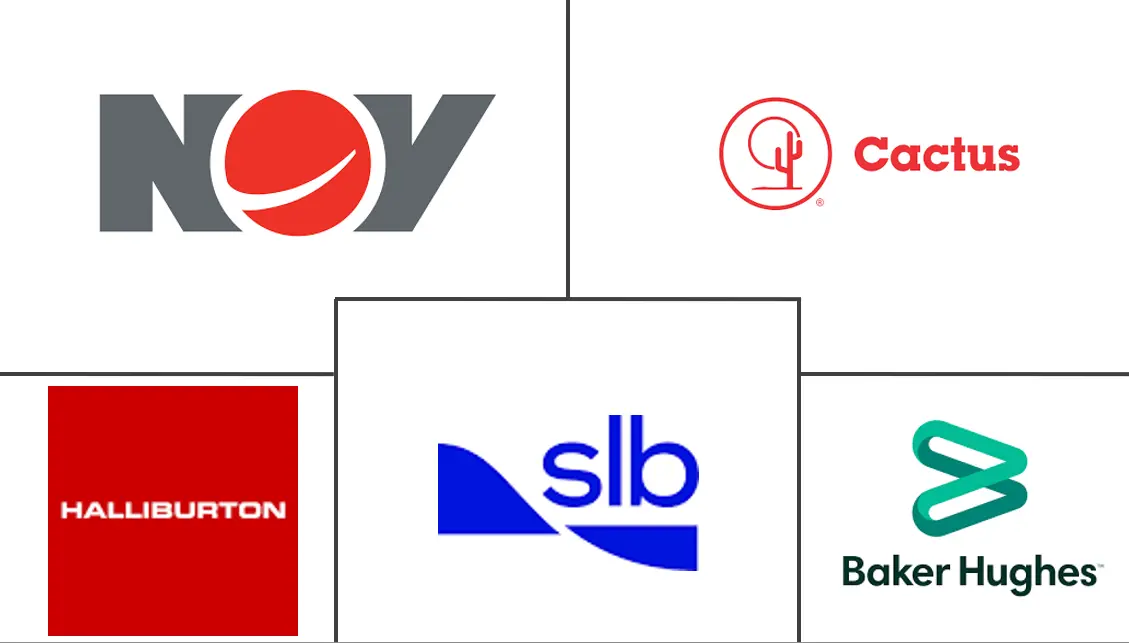Market Size of Middle-East And Africa Frac Stack Industry

| Study Period | 2019-2028 |
| Base Year For Estimation | 2022 |
| Market Size (2024) | USD 3.48 Billion |
| Market Size (2029) | USD 4.34 Billion |
| CAGR (2024 - 2029) | 4.50 % |
| Market Concentration | Medium |
Major Players
*Disclaimer: Major Players sorted in no particular order |
Middle-East And Africa Frac Stack Market Analysis
The Middle-East And Africa Frac Stack Market size is estimated at USD 3.48 billion in 2024, and is expected to reach USD 4.34 billion by 2029, growing at a CAGR of 4.5% during the forecast period (2024-2029).
- Over the medium term, factors such as increasing production from unconventional resources and growing energy demand are expected to drive the frac stack market during the forecast period.
- On the other hand, environmental concerns and a lack of capital markets and incentives are restraining market growth.
- Nevertheless, with the adoption of the Internet of Things (IoT) to analyze a large amount of data collected during exploration and production (E&P), advanced analytics and simulation software have become increasingly important in addressing safety concerns and improving the efficiency of the fracking process. Big Data analytics and IoT systems in fracking operations are likely to lead to significant opportunities for the frac stack market.
- Due to the shale boom, Saudi Arabia is expected to be the largest market for frac stacks. This has led to increased exploitation of shale reserves that need to be fractured for economic production.
Middle-East And Africa Frac Stack Industry Segmentation
Frac stacks are usually composed of upper and lower master valves, flow crosses, wing valves, goat heads, and swab valves. Since hydraulic fracturing requires high flow rates and pressures, frac stacks typically have larger bores and higher pressure ratings than production trees.
The Middle-East and Africa frac stack market is segmented by location of deployment, well type, and geography. By location of deployment, the market is segmented into onshore and offshore. By well type, the market is segmented into horizontal and deviated, vertical. The report also covers the market size and forecasts for the frac stack market across major countries in the region. For each segment, the market sizing and forecasts have been done based on revenue (USD).
| Location of Deployment | |
| Onshore | |
| Offshore |
| Well Type | |
| Horizontal and Deviated | |
| Vertical |
| Geography (Regional Market Analysis {Market Size and Demand Forecast till 2028 (for regions only)}) | |
| Saudi Arabia | |
| United Arab Emirates | |
| Nigeria | |
| Rest of Middle-East and Africa |
Middle-East And Africa Frac Stack Market Size Summary
The Middle-East and Africa frac stack market is poised for growth, driven by increasing production from unconventional resources and rising energy demand. The market is expected to expand over the forecast period, despite challenges such as environmental concerns and limited capital markets. The integration of advanced technologies like IoT and Big Data analytics is anticipated to enhance the efficiency and safety of fracking operations, creating significant opportunities for market expansion. Saudi Arabia is projected to be a key player in this market due to its shale boom, which necessitates the use of frac stacks to optimize well productivity. The onshore segment is expected to dominate the market, supported by the region's extensive onshore reserves and the logistical advantages of onshore operations.
Saudi Arabia's strategic initiatives, such as the Vision 2030 framework, further bolster its position in the frac stack market. The country's focus on enhancing onshore oil and gas operations and adopting advanced extraction technologies aligns with the growing demand for frac stacks. Saudi Arabia's central geographical location facilitates cost-effective transportation and logistics, making onshore projects more attractive. The stability of its regulatory environment enhances investor confidence, supporting long-term planning and growth in the frac stack market. Major industry players, including Halliburton, Schlumberger, and Baker Hughes, are actively involved in the region, contributing to the market's semi-consolidated nature. As the oil and gas sector continues to expand, the demand for frac stacks is expected to rise, positioning Saudi Arabia as a frontrunner in the Middle-East and Africa frac stack market.
Middle-East And Africa Frac Stack Market Size - Table of Contents
-
1. MARKET OVERVIEW
-
1.1 Introduction
-
1.2 Market Size and Demand Forecast in USD, till 2029
-
1.3 Recent Trends and Developments
-
1.4 Government Policies and Regulations
-
1.5 Market Dynamics
-
1.5.1 Drivers
-
1.5.1.1 Increasing Production from Unconventional Sources
-
1.5.1.2 Growing Energy Demand in the Region
-
-
1.5.2 Restraints
-
1.5.2.1 Environmental Concerns
-
-
-
1.6 Supply Chain Analysis
-
1.7 Porter's Five Forces Analysis
-
1.7.1 Bargaining Power of Suppliers
-
1.7.2 Bargaining Power of Consumers
-
1.7.3 Threat of New Entrants
-
1.7.4 Threat of Substitutes Products and Services
-
1.7.5 Intensity of Competitive Rivalry
-
-
-
2. MARKET SEGMENTATION
-
2.1 Location of Deployment
-
2.1.1 Onshore
-
2.1.2 Offshore
-
-
2.2 Well Type
-
2.2.1 Horizontal and Deviated
-
2.2.2 Vertical
-
-
2.3 Geography (Regional Market Analysis {Market Size and Demand Forecast till 2028 (for regions only)})
-
2.3.1 Saudi Arabia
-
2.3.2 United Arab Emirates
-
2.3.3 Nigeria
-
2.3.4 Rest of Middle-East and Africa
-
-
Middle-East And Africa Frac Stack Market Size FAQs
How big is the Middle-East And Africa Frac Stack Market?
The Middle-East And Africa Frac Stack Market size is expected to reach USD 3.48 billion in 2024 and grow at a CAGR of 4.5% to reach USD 4.34 billion by 2029.
What is the current Middle-East And Africa Frac Stack Market size?
In 2024, the Middle-East And Africa Frac Stack Market size is expected to reach USD 3.48 billion.

